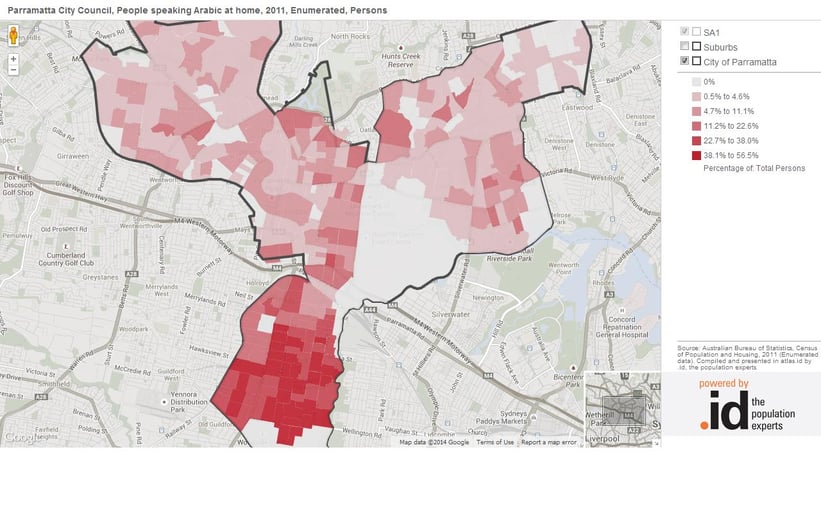In a previous blog I used Parramatta’s communities of interest module to look at the story of people born in India.
The great thing about communities of interest is that there can be a different story to tell for each diverse community.
In this blog I look at the Arabic speaking community, defined by a language rather than a birthplace. And there are some interesting findings!

Arabic speakers, particularly Lebanese, have a long association with Western Sydney, particularly Auburn, Canterbury, Bankstown and Parramatta.
The Arabic speakers of Parramatta are concentrated in the southern part of the LGA, forming a migration corridor with these other areas. It’s a highly concentrated population in one part of the city, and some of these areas have up to 50% of the population speaking Arabic. This includes suburbs such as Guildford, South Granville and Merrylands.

The Arabic speakers of Parramatta are relatively young, compared to the total population of Parramatta, and it’s not young adults, who are the main group of the Arab population, but school-age children, in particular, who are dominant. There has also been an increase in Arabic speakers but not of the magnitude of the increase in Indians. It’s up about 10%. This is a well-established community.
The Arabic community mainly comprises family groups, with 74% in couples families with children (total population average is 53%), and these are large families, probably with extended families living in one household. Fully 34% of all households containing one or more Arabic speaker had 6 or more people in them, while the total population average was only 11.7% for Parramatta. The households are large even compared to Arabic speakers across Sydney where there are 28.7% in 6 or more person households. But the largest increase was in somewhat smaller, 4 person households, indicating this trend is moderating.
The large households do equate to somewhat larger dwellings as well, with 82% of Arabic speakers living in separate houses (rather than higher density forms) and most live in 3, 4 or 5 bedroom dwellings. They are utilizing this space!
The part of Parramatta where Arabic speakers mainly live is the lower socio-economic area, and Arabic speakers do have a higher unemployment rate than the Parramatta average (10.6% to 6.2%). The participation rate (the proportion of population in the workforce or looking for work) is also quite low at 46.1% which may reflect fewer women in the workforce. With these factors, it’s not surprising that incomes for this group are relatively low – the lower middle income quartile is the largest but incomes are also skewed upwards by the larger household sizes, so equivalised household income is probably even lower.
But the most interesting characteristic of the Arabic speaking population concerns their origin. This is a well established community. Many people assume that those speaking a non-English language at home represent recent migrants, but this is not the case for this community. Parramatta’s Arabic speakers who were born overseas mostly arrived in Australia in the 1960s and 1970s. This contrasts with the Indian population who mostly arrived since 2000.
The countries of birth for Arabic speakers in Parramatta are fascinating. A large number (34.1%) were born in Lebanon, and other Arabic speaking countries are also represented, including Iraq, Syria, Egypt and Saudi Arabia.
However the largest country of birth for Arabic speakers by a long way is Australia. That’s right, 50.3% of Parramatta’s Arabic speakers were born here in Australia. This is a majority of the population. And an even more interesting fact (the sort you might find in a local trivia night perhaps) is that the total percentage of Parramatta’s residents born in Australia is 48.6%, which is less than that of Arabic speakers.
So if you’re in Parramatta, and someone starts speaking Arabic to you – there is a higher probability that they were born in this country than someone you pick randomly off the street!
We’ve used the new Community of Interest module in profile.id to do this analysis.













